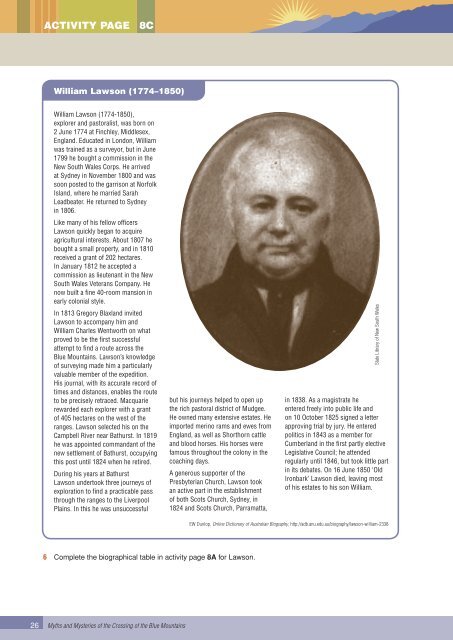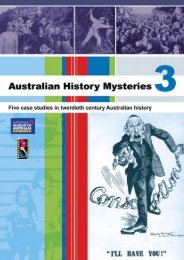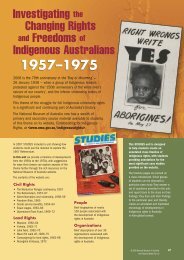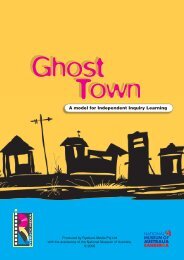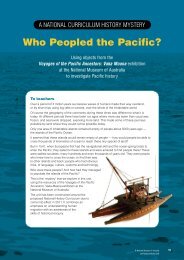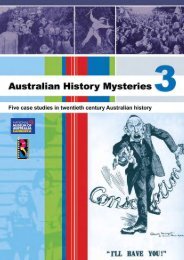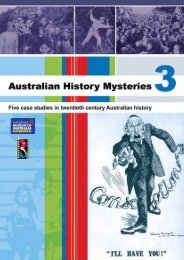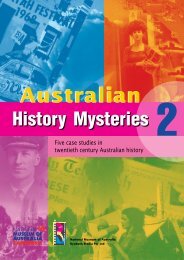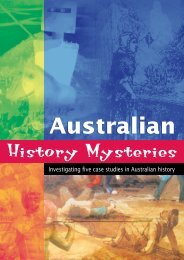Download Teacher Guide & Print Resources - Australian History ...
Download Teacher Guide & Print Resources - Australian History ...
Download Teacher Guide & Print Resources - Australian History ...
You also want an ePaper? Increase the reach of your titles
YUMPU automatically turns print PDFs into web optimized ePapers that Google loves.
Activity page<br />
8C<br />
William Lawson (1774–1850)<br />
William Lawson (1774-1850),<br />
explorer and pastoralist, was born on<br />
2 June 1774 at Finchley, Middlesex,<br />
England. Educated in London, William<br />
was trained as a surveyor, but in June<br />
1799 he bought a commission in the<br />
New South Wales Corps. He arrived<br />
at Sydney in November 1800 and was<br />
soon posted to the garrison at Norfolk<br />
Island, where he married Sarah<br />
Leadbeater. He returned to Sydney<br />
in 1806.<br />
Like many of his fellow officers<br />
Lawson quickly began to acquire<br />
agricultural interests. About 1807 he<br />
bought a small property, and in 1810<br />
received a grant of 202 hectares.<br />
In January 1812 he accepted a<br />
commission as lieutenant in the New<br />
South Wales Veterans Company. He<br />
now built a fine 40-room mansion in<br />
early colonial style.<br />
In 1813 Gregory Blaxland invited<br />
Lawson to accompany him and<br />
William Charles Wentworth on what<br />
proved to be the first successful<br />
attempt to find a route across the<br />
Blue Mountains. Lawson’s knowledge<br />
of surveying made him a particularly<br />
valuable member of the expedition.<br />
His journal, with its accurate record of<br />
times and distances, enables the route<br />
to be precisely retraced. Macquarie<br />
rewarded each explorer with a grant<br />
of 405 hectares on the west of the<br />
ranges. Lawson selected his on the<br />
Campbell River near Bathurst. In 1819<br />
he was appointed commandant of the<br />
new settlement of Bathurst, occupying<br />
this post until 1824 when he retired.<br />
During his years at Bathurst<br />
Lawson undertook three journeys of<br />
exploration to find a practicable pass<br />
through the ranges to the Liverpool<br />
Plains. In this he was unsuccessful<br />
but his journeys helped to open up<br />
the rich pastoral district of Mudgee.<br />
He owned many extensive estates. He<br />
imported merino rams and ewes from<br />
England, as well as Shorthorn cattle<br />
and blood horses. His horses were<br />
famous throughout the colony in the<br />
coaching days.<br />
A generous supporter of the<br />
Presbyterian Church, Lawson took<br />
an active part in the establishment<br />
of both Scots Church, Sydney, in<br />
1824 and Scots Church, Parramatta,<br />
State Library of New South Wales<br />
in 1838. As a magistrate he<br />
entered freely into public life and<br />
on 10 October 1825 signed a letter<br />
approving trial by jury. He entered<br />
politics in 1843 as a member for<br />
Cumberland in the first partly elective<br />
Legislative Council; he attended<br />
regularly until 1846, but took little part<br />
in its debates. On 16 June 1850 ‘Old<br />
Ironbark’ Lawson died, leaving most<br />
of his estates to his son William.<br />
EW Dunlop, Online Dictionary of <strong>Australian</strong> Biography, http://adb.anu.edu.au/biography/lawson-william-2338<br />
6 Complete the biographical table in activity page 8A for Lawson.<br />
26<br />
Myths and Mysteries of the Crossing of the Blue Mountains


